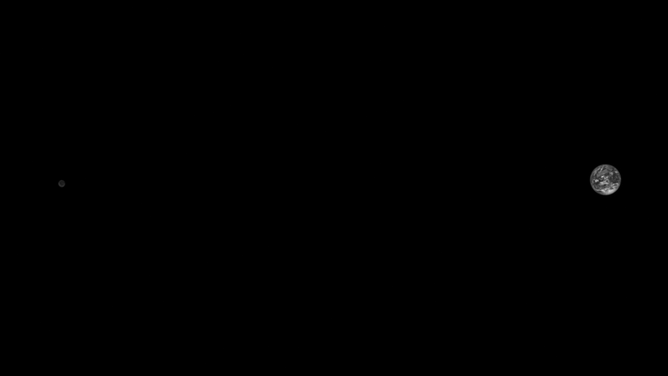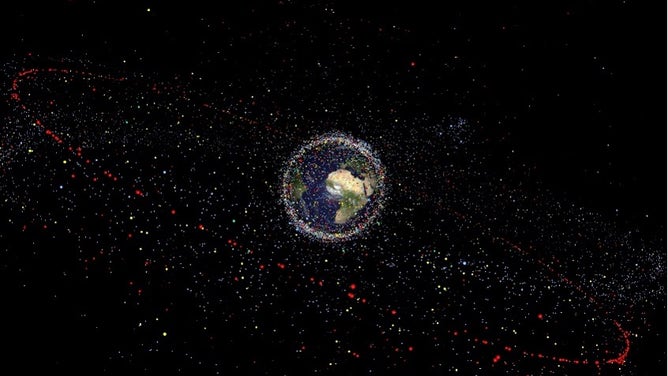NASA's Lucy spacecraft says hello to Earth on its way to study Trojan asteroids
A year after launching, Lucy skimmed by Earth, coming as close as 220 miles above the surface. This maneuver shoots Lucy out into space on a 2-year orbit before the spacecraft will return for a second gravity assist.

NASA’s Lucy spacecraft captured this image (which has been cropped) of the Earth on Oct 15, 2022, as a part of an instrument calibration sequence at a distance of 380,000 miles (620,000 km). The upper left of the image includes a view of Hadar, Ethiopia, home to Lucy, the 3.2 million-year-old human ancestor fossil for which the spacecraft was named. (Credits: NASA/Goddard/SwRI)
One year after launching, NASA's Lucy spacecraft zoomed by Earth capturing images of our home planet as it continued a 12-year journey to study asteroids considered fossils of our solar system.
Lucy will perform three Earth flybys, each providing a gravity-assisting boost into deep space to study a group of objects known as Trojan asteroids. These asteroids are made up of the same materials as the giant planets of our solar system: Jupiter, Saturn and Uranus.
Associated with Jupiter because the asteroids are on the same orbital path, two groups of Trojan asteroids zoom ahead of Jupiter and trail behind the gas giant.
Lucy was named after the fossils found in Ethiopia in 1974. The skeleton, one of human's oldest known ancestors, was named after The Beatles' song "Lucy In The Sky With Diamonds" after a night of celebrating the discovery while listening to the band's songs.
United Launch Alliance successfully delivered Lucy to orbit just before sunrise on Oct. 16, 2021, launching the Atlas V rocket from Cape Canaveral Space Force Station in Florida.
According to NASA, Lucy skimmed by Earth a year later, coming as close as 220 miles above the surface. This maneuver shoots Lucy into space on a two-year orbit before the spacecraft returns for a second gravity assist. The spacecraft will encounter its first Trojan asteroids in 2027 before a final slingshot by Earth in 2030.
The close encounter was a chance for Lucy's team on Earth to calibrate the spacecraft's instruments by photographing the Earth and the moon. The images were taken by Lucy’s Terminal Tracking Camera (T2CAM) system, a pair of cameras operated by Lockheed Martin that will later track the Trojan asteroids during Lucy’s encounters.

On October 13, 2022, NASA’s Lucy spacecraft captured this image of the Earth and the moon from a distance of 890,000 miles with Lucy’s Terminal Tracking Camera (T2CAM) system, a pair of identical cameras that are responsible for tracking asteroids. The T2CAM system was designed, built and tested by Malin Space Science Systems; Lockheed Martin Integrated the T2CAMs onto the Lucy spacecraft and operates them. (Image: Credit: NASA/Goddard/SwRI)
Lucy's body is about the size of a large deep freezer and has two huge solar wings spread out 24 feet each to power the mission. However, shortly after launching, NASA engineers discovered one of Lucy's wings did not open properly, and teams had to troubleshoot the issue. The wing is now about 355 degrees out of 360 degrees open, but even the tiny difference meant changing Lucy's game plan for the Earth slingshot.
"In the original plan, Lucy was actually going to pass about 30 miles closer to the Earth," Lucy project manager Rich Burns, with NASA’s Goddard Space Flight Center, said. "However, when it became clear that we might have to execute this flyby with one of the solar arrays unlatched, we chose to use a bit of our fuel reserves so that the spacecraft passes the Earth at a slightly higher altitude, reducing the disturbance from the atmospheric drag on the spacecraft’s solar arrays."
Lucy’s trajectory brought the spacecraft through a crowded area in low-Earth orbit full of satellites and debris. The team prepared two different maneuvers in case Lucy was at risk of colliding with a piece of space junk. About 12 hours before the closest approach, the spacecraft executed one of the maneuvers to avoid any potentially catastrophic collisions.

A graphic shows the distribution of space debris around Earth. Credits: European Space Agency
It just so happened Lucy's photo of Earth includes Hadar, Ethiopia, which is home to the 3.2-million-year-old fossils for which the spacecraft was named.
Lucy's flyby of Earth was closer than the International Space Station orbit and was even visible to people down on Earth in Western Australia and parts of the U.S.